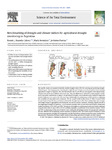Mostrar o rexistro simple do ítem
Benchmarking of Drought and Climate Indices for Agricultural Drought Monitoring in Argentina
| dc.contributor.author | Araneda-Cabrera, Ronnie J. | |
| dc.contributor.author | Bermúdez, María | |
| dc.contributor.author | Puertas, Jerónimo | |
| dc.date.accessioned | 2021-08-25T08:36:36Z | |
| dc.date.available | 2021-08-25T08:36:36Z | |
| dc.date.issued | 2021 | |
| dc.identifier.citation | Araneda-Cabrera, R. J., Bermudez, M., & Puertas, J. (2021). Benchmarking of drought and climate indices for agricultural drought monitoring in Argentina. Science of The Total Environment, v. 790, 148090. | es_ES |
| dc.identifier.uri | http://hdl.handle.net/2183/28322 | |
| dc.description | Financiado para publicación en acceso aberto: Universidade da Coruña/CISUG | es_ES |
| dc.description.abstract | [Abstract] Site-specific studies are required to identify suitable drought indices (DIs) for assessing and predicting drought-related impacts. This study presents a benchmark of eight DIs and 19 large-scale climate indices (CIs) to monitor agricultural drought in Argentina. First, the link between the CIs and DIs was investigated at the departmental-administrative level and at different temporal scales. Then, the effectiveness of the DIs in explaining the variability of crop yields, understood as impacts of agricultural droughts, was evaluated using statistical regression models. Soybeans were used as the reference crop. Additionally, the performances of DIs and CIs in explaining the variability of crop yields were compared. The CIs located in the Pacific Ocean (El Niño 3.4 and El Niño 4) were found to have the best correlations with the DIs (R values up to 0.49). These relationships were stronger with longer temporal aggregations and during the wet and hot seasons (summer), showing a significant role in the triggering of droughts in Argentina. The DIs that best corelated with CIs were those that included temperature in their calculations (STCI, SVHI, and SPEI). The impacts of droughts on soybean production were better explained using DIs than with CIs (up to 89% vs 8% of variability explained) as predictors of the statistical models. SVHI-6 and SPEI-6, depending on the area of interest, were, during the phenological period of crop growth (summer), the most effective DIs in explaining annual variations in soybean yields. The results may be of interest in water resource management, drought risk management, and the Argentinean soybean production sector. Furthermore, they provide a foundation for future studies aimed at forecasting agricultural droughts and their impacts. | es_ES |
| dc.description.sponsorship | Xunta de Galicia; ED481A-2018/162 | es_ES |
| dc.description.sponsorship | Ronnie Araneda gratefully acknowledges financial support from the Spanish Regional Government of Galicia (Xunta de Galicia) and the European Union through the predoctoral grant reference ED481A-2018/162. María Bermúdez was supported by the European Union H2020 Research and Innovation Program under the Marie Skłodowska-Curie Grant Agreement No. 754446 and the Research and Transfer Fund of the University of Granada - Athenea3i. | |
| dc.language.iso | eng | es_ES |
| dc.publisher | Elsevier | es_ES |
| dc.relation | eu-repo/grantAgreement/EC/H2020/754446 | es_ES |
| dc.relation.uri | https://doi.org/10.1016/j.scitotenv.2021.148090 | es_ES |
| dc.rights | Atribución-NoComercial-SinDerivadas 4.0 International (CC BY-NC-ND 4.0) | es_ES |
| dc.rights.uri | https://creativecommons.org/licenses/by-nc-nd/4.0/ | * |
| dc.subject | Drought indices | es_ES |
| dc.subject | Agricultural drought | es_ES |
| dc.subject | Teleconnections | es_ES |
| dc.subject | Statistical models | es_ES |
| dc.subject | Soybean yield | es_ES |
| dc.title | Benchmarking of Drought and Climate Indices for Agricultural Drought Monitoring in Argentina | es_ES |
| dc.type | info:eu-repo/semantics/article | es_ES |
| dc.rights.access | info:eu-repo/semantics/openAccess | es_ES |
| UDC.journalTitle | Science of The Total Environment | es_ES |
| UDC.volume | 790 | es_ES |
| UDC.startPage | 148090 | es_ES |
| dc.identifier.doi | 10.1016/j.scitotenv.2021.148090 |
Ficheiros no ítem
Este ítem aparece na(s) seguinte(s) colección(s)
-
CITEEC-GEAMA - Artigos [90]
-
OpenAIRE [288]






